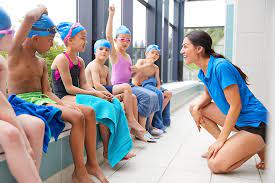If you’re wondering how much a swim teacher earns in Australia, you’re not alone. It’s a common question, especially for those fresh out of a water safety course or anyone thinking of diving into this rewarding career.
Quick answer:
- Entry-level swim teachers typically earn around $30 to $35 per hour.
- Experienced instructors or those with specialised skills can earn $40+ per hour.
- Full-time salaries (rare but possible) usually sit between $55,000 to $75,000 annually.
Now, let’s take a deeper look — because, like most things in life, the real story is in the details.
Why do swim teacher salaries vary so much?
You might think teaching kids to float and paddle is a pretty standard gig. In reality, salaries swing widely based on a few key factors:
- Certification Level – Higher qualifications, like completing a professional water safety course, open doors to better-paying roles.
- Location – Big city centres (like Sydney and Melbourne) often pay more than regional towns.
- Experience – Someone who’s taught hundreds of kids — and dealt with every meltdown and backstroke mishap — can charge more.
- Type of Facility – Swim schools, private lessons, public pools — each has its own pay scale.
- Session Type – Group lessons vs. one-on-one coaching.
Anyone who’s spent time in swim teaching knows: managing a class of wriggly toddlers in a chilly pool deserves hazard pay. (Kidding. Mostly.)
What qualifications do you need to earn more?
Technically, you can’t just pop on some boardies and start shouting freestyle drills.
Australia has strong standards for swim instructors — and that’s a good thing. It keeps students safe and teachers respected.
To boost your income potential, you’ll want to complete a recognised water safety course, like:
- AUSTSWIM Teacher of Swimming and Water Safety™
- Swim Australia™ Teacher Certification
- Royal Life Saving Society Courses
Most employers list an AUSTSWIM certification as a non-negotiable. And for specialist gigs (infants, adults, people with disability), extra training means extra dollars.
Real-world tip: After working with dozens of swim centres, I’ve seen that staff with additional qualifications (like CPR, first aid, or an Infant and Preschool certificate) were first in line for pay raises.
Where are the best-paying swim teacher jobs?
If you’re chasing higher hourly rates, think beyond your local council pool. Some of the top-paying opportunities include:
- Private swim schools in affluent suburbs.
- Elite aquatic centres linked to major sports programs.
- Mobile swim instructors who travel to clients’ homes (often charging $80+ per lesson).
- Seasonal contracts at holiday resorts or beach programs (like lifeguard training camps).
Example:
A mate of mine switched from working at a small town pool ($29/hour) to a private indoor swim school in Brisbane ($42/hour) after picking up extra infant-teaching qualifications. Same skills — different paycheque.
How does experience impact swim teacher salaries?
When you’re new, you’re focused on remembering everyone’s name and not getting splashed in the face every five seconds.
But after a few seasons, something changes.
- First year: Expect to be casual or part-time at $30–$35/hr.
- 2–4 years: With good reviews, you can move to $37–$42/hr, possibly getting supervisory duties.
- 5+ years: Senior instructors often design programs, mentor juniors, and earn $45+/hr.
In some bigger aquatic centres, senior instructors even transition into aquatic program management — cracking the $70,000+ salary bracket.
(Anyone who’s organised a kids’ swim carnival knows this deserves a medal.)
Is being a swim teacher a good career choice?
Let’s be honest: It’s not for everyone.
You need patience. Endless patience. And a smile that holds up when it’s 7am and your students think ‘listening’ is optional.
But if you love the water, enjoy teaching, and thrive off seeing kids (and adults) achieve something life-changing, it’s a fantastic career.
The flexible hours also make it perfect for:
- Students
- Parents
- Retirees wanting casual work
- People after a second income stream
And the emotional pay-off? Huge. Helping someone overcome fear of the water is genuinely unforgettable.
(One of my proudest teaching memories is watching a 70-year-old woman learn to swim for the first time — tears, hugs, the whole lot.)
FAQs About Swim Teacher Pay in Australia
1. Can you earn a full-time wage as a swim teacher?
Yes, but it can be tricky. Most swim teaching jobs are casual. However, some large aquatic centres and schools offer full-time contracts, especially to those who take on extra responsibilities like training or admin.
2. Does seasonal work affect swim teacher salaries?
It can. In Australia, demand peaks in summer. Swim teachers may get more hours — and sometimes higher rates — during these months. Winter often sees a drop unless you’re at an indoor pool.
3. Is there demand for swim teachers in Australia?
Absolutely. With Australia’s love of the beach and pool, swim teaching is one of the most stable casual industries. Many schools even struggle to find enough qualified teachers, especially those with infant or disability specialisation.
Final thoughts: Worth dipping your toes in?
Teaching swimming in Australia is more than just a job. It’s part of the national culture.
Sure, you’re not going to buy a mansion on swim teacher wages. But the rewards — both emotional and financial — are real.
Especially if you invest in your skills through a reputable water safety course and keep building from there.
For anyone serious about building a flexible and meaningful aquatic career, completing your certification with AUSTSWIM is a smart first move.
And if you’re curious about advancing further, learning about becoming a certified swimming instructor might just spark your next big career step.

